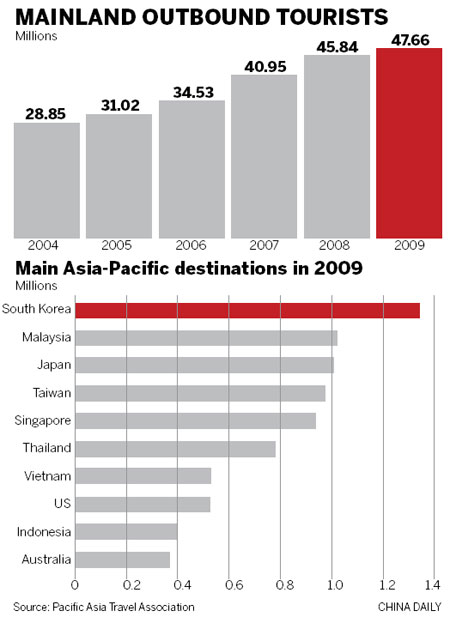InfoGraphic
Travel from China to Asia Pacific region jumps ahead
By Wang Zhuoqiong (China Daily)
Updated: 2010-10-25 11:09
 |
Large Medium Small |
|
 |
|
Asian tourists pass by a sign that says "Welcome to Chinese" in a restaurant street in the Myeong-dong district of Seoul. [Photo/Agencies] |

BEIJING - Chinese outbound travelers have contributed to double-digit growth in the number of people visiting the Asia-Pacific region, taking the estimated 45 million arrivals in 2010 to as much as 60 million in 2011, according to the Pacific Asia Travel Association (PATA).
Arrivals from China to the region are estimated to have grown by 30 percent in the first six months of 2010. If the current growth momentum is maintained, the collective number of arrivals from China to Asia-Pacific destinations could well surge past 45 million by the end of the year, PATA said in an e-mail interview with China Daily.
From just under 10 million in 2000, the China arrival numbers to total Asia-Pacific destinations - including Canada, Mexico and the United States - surged to 38 million in 2009.
This makes China the largest source market for the Asia- Pacific region by volume, one that grew by an average of a little over 16 percent every year for the past 10 years, according to the organization.
The resilience of the China outbound travel market is significant for the Asia-Pacific region in that it somewhat shields destinations from what could be much bigger losses in times of economic volatility and uncertainty, said John Koldowski, deputy chief executive officer and head, office of strategy management at PATA.
Chinese travelers have a vast spectrum in outbound destinations, from shopping holidays in Hong Kong to relaxing vacations in the Maldives and adventures in Australia, he told China Daily.
Recent trends show robust growth in arrivals from the Chinese mainland to island destinations including the Maldives and Guam. The latest 2010 results also indicate strong interest in, among other Pacific island destinations, Northern Marianas and Hawaii.
Taiwan and Singapore are expected to join South Korea and Malaysia as members of the "one-million arrivals from the Chinese mainland" club by the end of 2010.
From 2005 to 2009, arrivals from the mainland to Northeast Asia have grown 7 percent annually, led by South Korea and Japan at an increase of 7 percent and 11 percent respectively, although, in terms of volume, Hong Kong and Macao still lead, PATA's statistics show.
Travel to Southeast Asia, saw a total annual growth rate of 8 percent, with an increase of 21 percent visiting Cambodia, a 37 percent rise heading to Indonesia and 35 percent more people going to Laos.
Travel from China to South Asia has grown 21 percent. Since 2005, arrivals from China to India have doubled, Nepal has seen the numbers triple, while arrivals from China to the Maldives and Bhutan have increased five-fold.
The number of travelers from China to North America has risen 15 percent. North America is a key destination sub-region for mainland travelers, with the US capturing more than 70 percent of the total outbound numbers from China. Arrivals from China to the US almost doubled from 270,000 in 2005 to 525,000 in 2009.
Whilst spending by tourists from most developed economies declined during the global economic downturn, the average spend of outbound Chinese tourists was up by 13 per cent from $790 in 2008 to close to $900 in 2009, according to the Annual Report on China Outbound Tourism Development 2009-2010.
At the global aggregate level, the United Nations World Tourism Organization (UNWTO) estimates that Chinese international travelers spent around $43.7 billion last year - excluding expenditure on international transport.
This places China fourth in the world in terms of international travel expenditure, behind Germany, the US and the UK.
Prospects for continued growth in arrivals from China to Asia-Pacific destinations remain very bright as there is still a very large pool of Chinese mainland citizens who are yet to make their first overseas trip, Koldowski said.
With the country's economy continuing to power ahead, improving purchasing power and the quality of life will stimulate more overseas travel and, it is expected, to the Asia-Pacific region in particular, he added.



